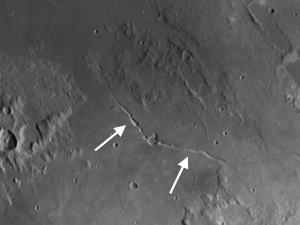The week of May 11-17 takes us from Lunar Day 20 to Day 25. This week we will highlight Rima Hyginus, viewable Wednesday morning, and Mare Vaporum, viewable Wednesday & Thursday mornings.
 Mare Vaporum: [NE/H10; L=4°E] Notice how there are finger-like projections extending from the back side of the Apennines into Mare Vaporum. It is not coincidental that these extensions point back to Mare Imbrium, as they are part of the ejecta that was thrown out during the initial impact. (This also makes the Sea of Vapors considerably younger than Mare Imbrium.)
Mare Vaporum: [NE/H10; L=4°E] Notice how there are finger-like projections extending from the back side of the Apennines into Mare Vaporum. It is not coincidental that these extensions point back to Mare Imbrium, as they are part of the ejecta that was thrown out during the initial impact. (This also makes the Sea of Vapors considerably younger than Mare Imbrium.)
 Rima Hyginus: [NE/J10; L=8°E] At the west end of the Ariadaeus rille, there is a narrow diagonal shunt that connects Ariadaeus to Rima Hyginus. This new rille parallels Rima Ariadaeus for about 20 miles, then continues west until it encounters the small 6-mile crater Hyginus. At that precise point it changes direction and veers northward toward Mare Vaporum. The fact that Hyginus crater is located precisely at the pivot point is a curiosity. Can this just be coincidence?
Rima Hyginus: [NE/J10; L=8°E] At the west end of the Ariadaeus rille, there is a narrow diagonal shunt that connects Ariadaeus to Rima Hyginus. This new rille parallels Rima Ariadaeus for about 20 miles, then continues west until it encounters the small 6-mile crater Hyginus. At that precise point it changes direction and veers northward toward Mare Vaporum. The fact that Hyginus crater is located precisely at the pivot point is a curiosity. Can this just be coincidence?
Rima Hyginus is 2.5 miles wide and is easily seen in very small telescopes. It is really made up of a line of linked craters which are best seen just northwest of the crater Hyginus. With good optics and steady seeing you might be able to make some of these out even with a three-inch scope. Charles Wood suggests that these are actually rimless collapse pits of internal origin and that the crater Hyginus (also rimless) might be one of their number. Can you see any of the individual craters, or does Rima Hyginus just look like a linear feature?
======================
It is highly recommended that you get a copy of Sky and Telescope’s Field Map of the Moon, the very finest Moon map available for use at the telescope. It is available for $10.95 at www.skyandtelescope.com and on Amazon. All features mentioned in this blog will be keyed to the grid on the Field Map and will look like this: Plato: [NW/D9]
Credits:
Courtesy of Gray Photography of Corpus Christi, Texas
Lunar photos: NASA / USGS / BMDO / LROC / ASU / DLR / LOLA / Moon Globe. Used by permission
- Rupes Cauchy: A Best Known Fault on the Moon - July 22, 2024
- Moon Crater Schickard – Crater Floor has Stripes - July 15, 2024
- Moon Craters Langrenus and Vandelinus - July 8, 2024